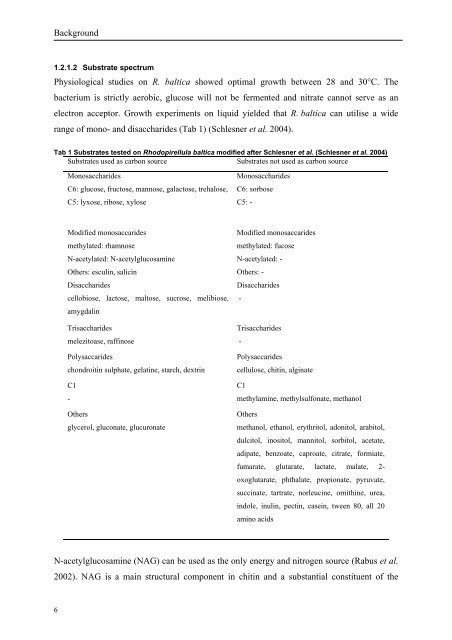a Whole Genome Array Approach - Jacobs University
a Whole Genome Array Approach - Jacobs University
a Whole Genome Array Approach - Jacobs University
You also want an ePaper? Increase the reach of your titles
YUMPU automatically turns print PDFs into web optimized ePapers that Google loves.
Background<br />
1.2.1.2 Substrate spectrum<br />
Physiological studies on R. baltica showed optimal growth between 28 and 30°C. The<br />
bacterium is strictly aerobic, glucose will not be fermented and nitrate cannot serve as an<br />
electron acceptor. Growth experiments on liquid yielded that R. baltica can utilise a wide<br />
range of mono- and disaccharides (Tab 1) (Schlesner et al. 2004).<br />
Tab 1 Substrates tested on Rhodopirellula baltica modified after Schlesner et al. (Schlesner et al. 2004)<br />
Substrates used as carbon source<br />
Substrates not used as carbon source<br />
Monosaccharides<br />
C6: glucose, fructose, mannose, galactose, trehalose,<br />
C5: lyxose, ribose, xylose<br />
Monosaccharides<br />
C6: sorbose<br />
C5: -<br />
Modified monosaccarides<br />
methylated: rhamnose<br />
N-acetylated: N-acetylglucosamine<br />
Others: esculin, salicin<br />
Disaccharides<br />
cellobiose, lactose, maltose, sucrose, melibiose,<br />
amygdalin<br />
Trisaccharides<br />
melezitoase, raffinose<br />
Polysaccarides<br />
chondroitin sulphate, gelatine, starch, dextrin<br />
C1<br />
-<br />
Others<br />
glycerol, gluconate, glucuronate<br />
Modified monosaccarides<br />
methylated: fucose<br />
N-acetylated: -<br />
Others: -<br />
Disaccharides<br />
-<br />
Trisaccharides<br />
-<br />
Polysaccarides<br />
cellulose, chitin, alginate<br />
C1<br />
methylamine, methylsulfonate, methanol<br />
Others<br />
methanol, ethanol, erythritol, adonitol, arabitol,<br />
dulcitol, inositol, mannitol, sorbitol, acetate,<br />
adipate, benzoate, caproate, citrate, formiate,<br />
fumarate, glutarate, lactate, malate, 2-<br />
oxoglutarate, phthalate, propionate, pyruvate,<br />
succinate, tartrate, norleucine, ornithine, urea,<br />
indole, inulin, pectin, casein, tween 80, all 20<br />
amino acids<br />
N-acetylglucosamine (NAG) can be used as the only energy and nitrogen source (Rabus et al.<br />
2002). NAG is a main structural component in chitin and a substantial constituent of the<br />
6

















